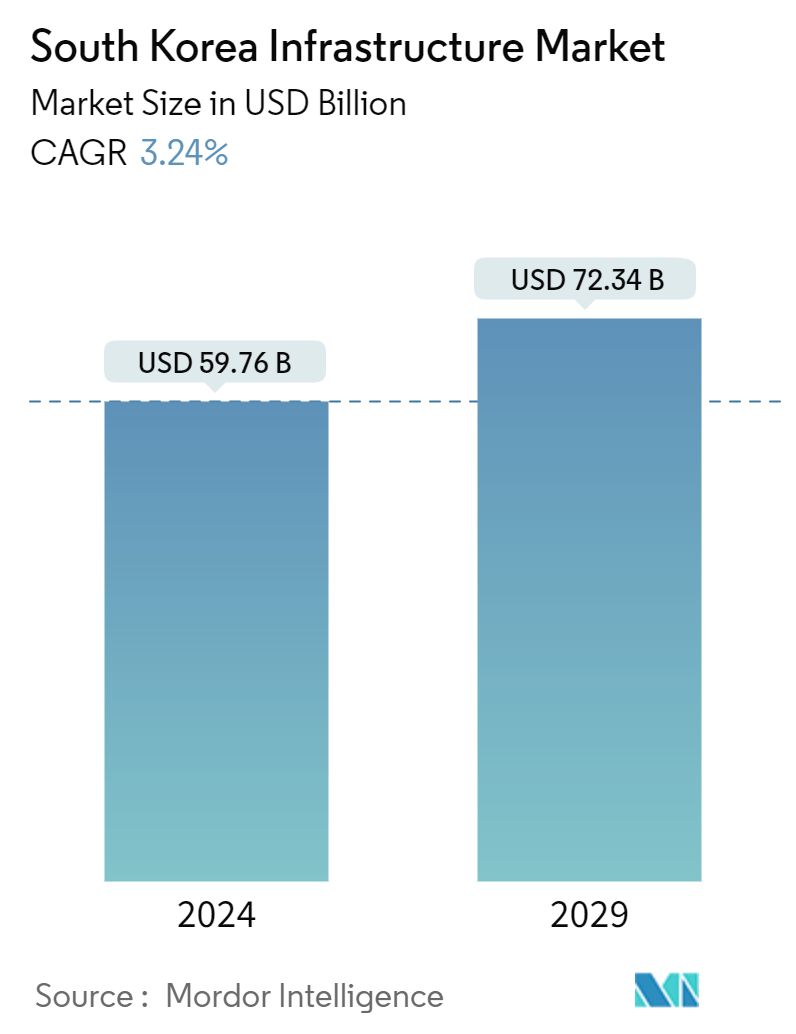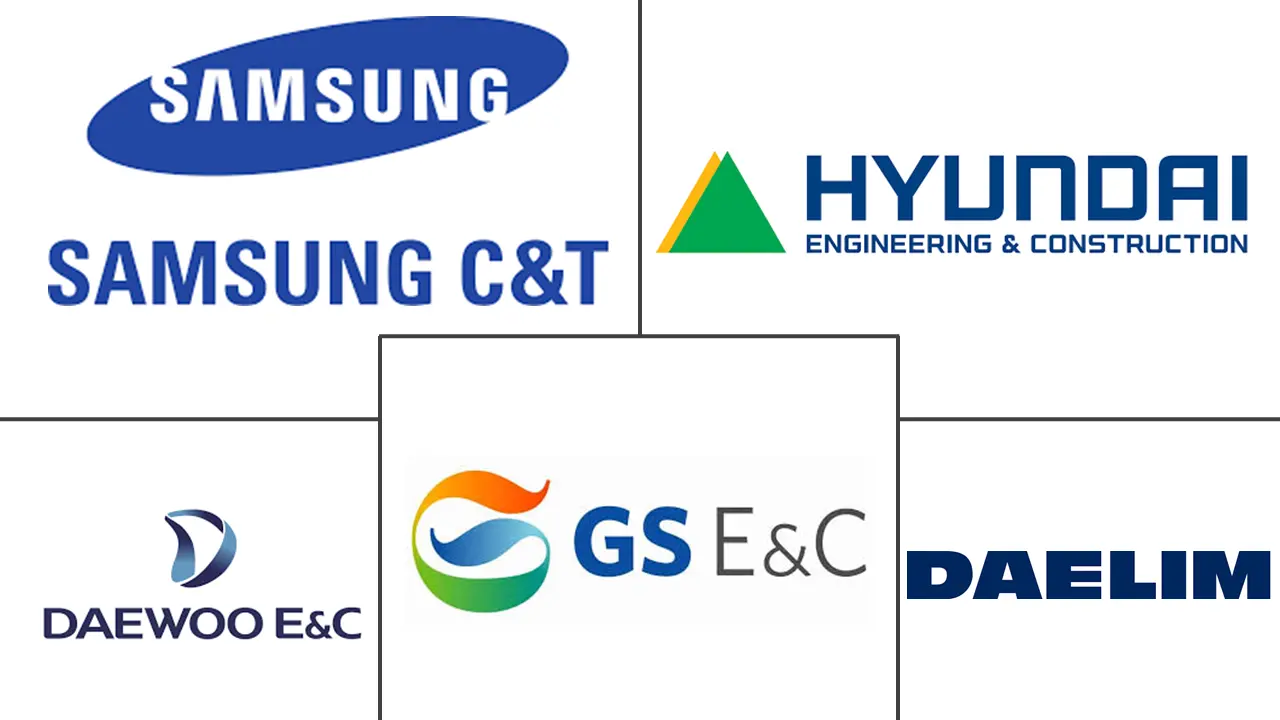Market Size of South Korea Infrastructure Industry

| Study Period | 2020 - 2029 |
| Base Year For Estimation | 2023 |
| Market Size (2024) | USD 59.76 Billion |
| Market Size (2029) | USD 72.34 Billion |
| CAGR (2024 - 2029) | 3.24 % |
| Market Concentration | Medium |
Major Players
*Disclaimer: Major Players sorted in no particular order |
South Korea Infrastructure Market Analysis
The South Korea Infrastructure Market size is estimated at USD 59.76 billion in 2024, and is expected to reach USD 72.34 billion by 2029, growing at a CAGR of 3.24% during the forecast period (2024-2029).
- South Korea is an ideal market for US firms seeking to test cybersecurity solutions before deploying them in other markets due to its leadership in high-speed internet use and advanced ICT infrastructure.
- While companies that create sophisticated and cutting-edge products for critical infrastructure are more likely to succeed, there are also opportunities for companies that provide cybersecurity consulting and training services. Overall, the Korean market prefers the quality and dependability of American products, and demand for American goods is expected to remain strong. South Korea is developing its AI capabilities and wants to become a global player in the AI technology markets. ROK officials see AI as critical to the country's ICT prowess and are committed to making Korea an AI powerhouse.
- One of the key factors driving the growth of the VDI market in South Korea is the growing need for remote support across various organizations. Remote support software is in high demand due to increasing internet speeds and the need for cost-effective solutions to optimize various business operations. Also, remote support software solutions benefit businesses that focus on resolving end-user technical issues.
- Many consumers use solutions for battery optimization, firmware support, and malware detection. Many small businesses are equipping their IT help desks with remote support software to provide technical support to such customers. The growing demand for remote support solutions will drive market growth during the forecast period.
- Because of information and communication technology advances, the mobility sector is undergoing a major transformation. The South Korean government's Ministry of Land, Infrastructure, and Transport has unveiled the "Mobility Innovation Roadmap" to establish its leadership in the mobility sector and promote innovative services.
- The ministry formed the 'Mobility Innovation Committee,' which is made up of private-sector experts working solely in the fields of transportation, consumer, and information technology. The ministry intends to expand and reorganize the Mobility Innovation Committee into a public-private joint organization to ensure the mobility roadmap's smooth implementation, review the roadmap's implementation status, and discuss the discovery of new tasks and the supplementation of existing ones.
- South Korea's exports reached USD 644.5 billion in 2021, the highest ever, owing to strong sales of major industries and the growth of new industries. Despite the COVID-19 pandemic, Korean firms were able to minimize production disruptions, and major industries such as semiconductors, shipbuilding, and automobiles led the global market in terms of product competitiveness. Cosmetics, agriculture, marine products, and plastics were among the new export industries that grew significantly.
- In 2023, the top 15 major export items, which included semiconductors, petrochemicals, and automobiles, increased by double digits. It is the first time that all 15 items have increased simultaneously. This has been made possible by the country's infrastructure growth, which the country's manufacturing growth has supplemented.
South Korea Infrastructure Industry Segmentation
Infrastructure is referred to as the fundamental physical framework of an organization, region, or country. It frequently pertains to the creation of public goods or industrial activities. A complete background analysis of the South Korean infrastructure market, including the assessment of the economy and contribution of sectors in the economy, market overview, market size estimation for key segments, and emerging trends in the market segments, market dynamics, and geographical trends, and the COVID-19 impact is included in the report.
The South Korean infrastructure market is segmented by type (social, transportation, extraction, and manufacturing infrastructure). The report offers market size and forecasts for the South Korean infrastructure market in value (USD) for all the above segments.
| By Type | |||||||
| |||||||
| |||||||
| |||||||
|
South Korea Infrastructure Market Size Summary
The South Korea infrastructure market is experiencing significant growth, driven by substantial investments in transportation and IT-enabled industries. The country's advanced ICT infrastructure and leadership in high-speed internet make it an attractive market for US firms, particularly those in cybersecurity and AI technology sectors. The government's initiatives, such as the Mobility Innovation Roadmap, aim to transform the mobility sector, promoting autonomous vehicles and urban air mobility. This transformation is supported by key transportation projects and the development of real-time communication infrastructure, which are expected to enhance public transportation and address traffic congestion. The market's expansion is further bolstered by the country's robust export performance and the growth of new industries, supported by infrastructure development.
In the medical sector, South Korea is advancing towards becoming a smart healthcare hub, with significant opportunities for Western technology companies. The country's high adoption of electronic medical record systems and digital health technologies reflects its commitment to digitizing healthcare. The government's plan to establish smart hospitals by 2025 presents opportunities for international companies to introduce innovative health information technology solutions. The infrastructure market in South Korea is moderately fragmented, with local players dominating and global companies entering through partnerships and investments. Key players like Samsung C&T, Hyundai E&C, and others are leveraging advanced technologies to drive infrastructure development, aligning with the country's vision for a modernized and efficient infrastructure landscape.
South Korea Infrastructure Market Size - Table of Contents
-
1. MARKET INSIGHTS AND DYNAMICS
-
1.1 Current Economic and Construction Market Scenario
-
1.2 Technological Innovations in the industry
-
1.3 Impact of Government Regulations and Initiatives on the Industry
-
1.4 Market Drivers
-
1.4.1 Country's strong focus on innovation and technology
-
1.4.2 Promoting economic growth driving the market
-
-
1.5 Market Restraints
-
1.5.1 High cost of infrastructure development hindering the growth of the market
-
1.5.2 Complex regulatory environment affecting the market
-
-
1.6 Market Opportunities
-
1.6.1 Growing need for upgrading and expanding transportation networks
-
-
1.7 Industry Attractiveness - Porter's Five Forces Analysis
-
1.7.1 Threat of New Entrants
-
1.7.2 Bargaining Power of Buyers/Consumers
-
1.7.3 Bargaining Power of Suppliers
-
1.7.4 Threat of Substitute Products
-
1.7.5 Intensity of Competitive Rivalry
-
-
1.8 Value Chain / Supply Chain Analysis
-
1.9 Impact of COVID-19 on the Market
-
-
2. MARKET SEGMENTATION
-
2.1 By Type
-
2.1.1 Social Infrastructure
-
2.1.1.1 Schools
-
2.1.1.2 Hospitals
-
2.1.1.3 Defense
-
2.1.1.4 Other Types
-
-
2.1.2 Transportation Infrastructure
-
2.1.2.1 Railways
-
2.1.2.2 Roadways
-
2.1.2.3 Airports
-
2.1.2.4 Waterways
-
-
2.1.3 Extraction Infrastructure
-
2.1.3.1 Power Generation
-
2.1.3.2 Electricity Transmission and Disribution
-
2.1.3.3 Water
-
2.1.3.4 Gas
-
2.1.3.5 Telecom
-
-
2.1.4 Manufacturing Infrastructure
-
2.1.4.1 Metal and Ore Production
-
2.1.4.2 Petroleum Refining
-
2.1.4.3 Chemical Manufacturing
-
2.1.4.4 Industrial Parks and Clusters
-
2.1.4.5 Other Infrastructure
-
-
-
South Korea Infrastructure Market Size FAQs
How big is the South Korea Infrastructure Market?
The South Korea Infrastructure Market size is expected to reach USD 59.76 billion in 2024 and grow at a CAGR of 3.24% to reach USD 72.34 billion by 2029.
What is the current South Korea Infrastructure Market size?
In 2024, the South Korea Infrastructure Market size is expected to reach USD 59.76 billion.

